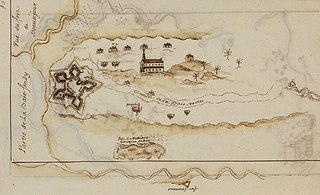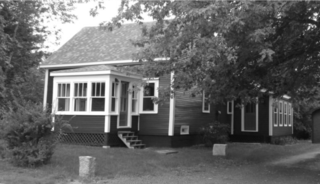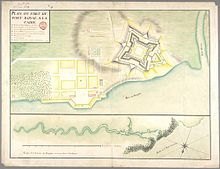
Citadel Hill is a hill that is a National Historic Site in Halifax, Nova Scotia, Canada. Four fortifications have been constructed on Citadel Hill since the city was founded by the English in 1749, and were referred to as Fort George—but only the third fort was officially named Fort George. According to General Orders of October 20, 1798, it was named after King George III. The first two and the fourth and current fort, were officially called the Halifax Citadel. The last is a concrete star fort.

Sackville is a former town in southeastern New Brunswick, Canada. It held town status prior to 2023 and is now part of the town of Tantramar.

Events from the 1630s in Canada.

Port-Royal National Historic Site is a National Historic Site located on the north bank of the Annapolis Basin in Granville Ferry, Nova Scotia, Canada. The site is the location of the Habitation at Port-Royal, which was the centre of activity for the New France colony of Port Royal in Acadia from 1605 to 1613, when it was destroyed by English forces from the Colony of Virginia.

Annapolis Royal is a town in and the county seat of Annapolis County, Nova Scotia, Canada. The community, known as Port Royal before 1710, is recognised as having one of the longest histories in North America, preceding the settlements at Plymouth, Jamestown and Quebec. For nearly 150 years, it served as the capital of Acadia and subsequently Nova Scotia until the establishment of Halifax in 1749.

Fort Beauséjour, renamed Fort Cumberland in 1755, is a large, five-bastioned fort on the Isthmus of Chignecto in eastern Canada, a neck of land connecting the present-day province of New Brunswick with that of Nova Scotia. The site was strategically important in Acadia, a French colony that included primarily the Maritimes, the eastern part of Quebec, and northern Maine of the later United States. The fort was built by the French from 1751 to 1752. They surrendered it to the British in 1755 after their defeat in the Battle of Fort Beauséjour, during the Seven Years' War. The British renamed the structure as Fort Cumberland. The fort was strategically important throughout the Anglo-French rivalry of 1749–63, known as the French and Indian Wars by British colonists. Less than a generation later, it was the site of the 1776 Battle of Fort Cumberland, when the British forces repulsed sympathisers of the American Revolution.
Sir William Alexander was the founder, in 1629, of the Scottish colony of Nova Scotia with the establishment of Charles Fort, now the site of modern Annapolis Royal, Nova Scotia, Canada. His expedition partner, James Stewart, 4th Lord Ochiltree established a short-lived settlement at Baleine on Cape Breton Island, some 600 km (373 mi) northeast.

Fort Anne is a historic fort protecting the harbour of Annapolis Royal, Nova Scotia. It was built by Scottish settlers in August 1629 as Charles Fort. For the first 120 years of the fort's service period, the settlement of Port Royal, later Annapolis Royal, was the capital of the New France colony of Acadia and British North America colony of Nova Scotia. In 1917, Fort Anne became the first National Historic Site of Canada. Although no longer in active service, it is the oldest extant fort in Canada. Fort Anne has provided more defensive service than any other fort in North America, having been attacked and blockaded at least 19 times over a service period of 225 years, from the Acadian Civil War through to the American Revolutionary War. The fort also contains the oldest military building in Canada and the oldest building administered by Parks Canada, the 1708 powder magazine.

Port Royal (1605–1713) was a historic settlement based around the upper Annapolis Basin in Nova Scotia, Canada, and the predecessor of the modern town of Annapolis Royal.

The following outline is provided as an overview of and topical guide to Nova Scotia:

The Argyle Township Court House & Gaol is a provincially and federally recognised heritage building along Route 308 in the present-day community of Tusket, Nova Scotia. Predating Canadian Confederation, it played a significant role in the administrative, judicial, and political spheres of life in the Municipality of the District of Argyle during the 19th and early 20th centuries. Also known as the Tusket Court House, the building is held to be "the oldest surviving combined court house and jail in Canada." No longer an active court house, the local landmark now serves as a museum and tourist destination.

The Bailey House in Annapolis Royal, Nova Scotia, Canada is a historic house built around 1770, making it one of the oldest wood frame houses in Canada. It has been operating as a lodging, with interruptions, since at least 1837. The building is a Georgian style and is largely unaltered since its original construction. The house is part of the Annapolis Royal Historic District.
The de Gannes-Cosby House in the Annapolis Royal Historic District is the oldest wood framed building in Canada. It is also the world's oldest existing building in the Acadian style. It was built in 1708 by Major Louis-Joseph de Gannes de Falaise, a French nobleman and officer stationed at the French colony of Port Royal in what is today the province of Nova Scotia. The house is built on the foundations of an earlier house destroyed during the 1707 Siege of Port Royal. The core house was a simple wattle and daub construction, but has since been covered in wooden shingles and enlarged in the 19th and 20th centuries. It has been designated as a National Historic Site and is part of the Annapolis Royal Historic District.

The Adams-Ritchie House is one of the oldest wood framed buildings in Canada. It is located in Annapolis Royal, Nova Scotia, Canada and dates from 1713. Over the past 300 years, the building was expanded and embellished until the original building was completely hidden. In the 1980s, it was restored to its original appearance. Prior to 1749, the house occasionally hosted the Nova Scotia Council, the fore-runner of the Nova Scotia House of Assembly.

The Annapolis County Courthouse is a courthouse located in Annapolis Royal, Nova Scotia, Canada. It was built in 1837 by Francis LeCain and was enlarged in 1923. The building is designated a National Historic Site of Canada. It is part of the Historic District of Annapolis Royal and is one of the oldest courthouses in Canada still in use.
The O'Dell House Museum is a house-museum located in Annapolis Royal, Nova Scotia, Canada which presents a collection of artefacts important to the history of Annapolis Royal. The museum also houses the Annapolis Heritage Society's Genealogy Centre and its Archive and Collections Centre. The original building was constructed in 1869 by Nova Scotia Pony Express rider, Corey O’Dell. A Victorian house in Greek revival style, it is part of the Historic District of Annapolis Royal.

Saint Luke's Anglican Church is a historic church located in Annapolis Royal, Nova Scotia, Canada. Constructed in 1815, the church served the British garrison stationed at Fort Anne until the garrison's removal to Halifax in 1854. The building is part of the Historic District of Annapolis Royal.

The Bonnett House in Annapolis Royal, Nova Scotia, Canada is a historic house built around 1773, making it one of the oldest wood-frame houses in Canada. The building is a Georgian style and is largely unaltered since its original construction. The house is part of the Annapolis Royal Historic District.

The Williams House is a historic house located in Annapolis Royal, Nova Scotia, Canada. Constructed in 1715, the building was located at 248 Saint George Street until 1875 when the main portion of the house was moved to 167 Saint Anthony Street. The ell of the house, dating from c. 1730, was moved to 62 Chapel Street. Although the location has moved, it remains one of the oldest wood-framed houses in Canada. The building is part of the Historic District of Annapolis Royal.




















